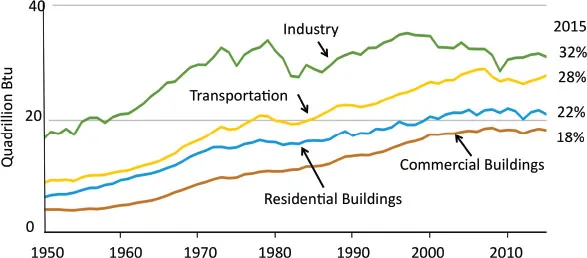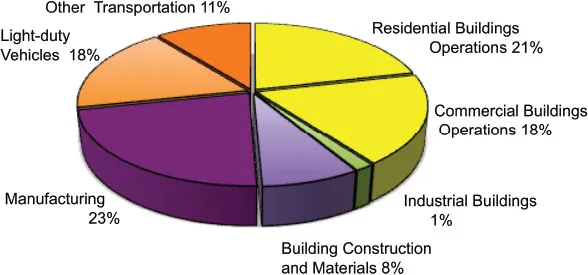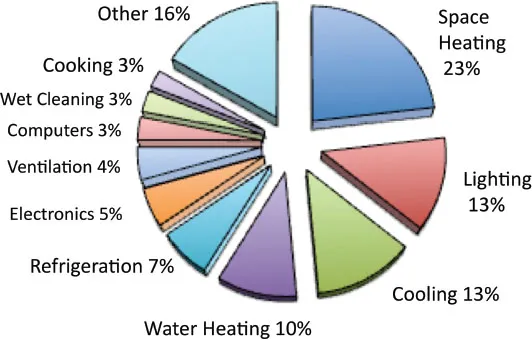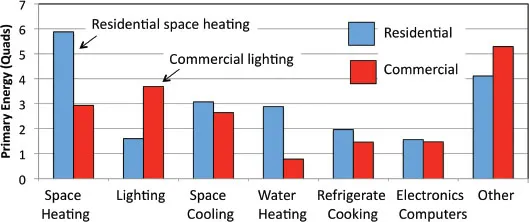![]()
SECTION III:
BUILDINGS AND ENERGY
Chapter 6: Energy Efficiency for Buildings
Chapter 7: Solar Energy for Buildings: Approaching Zero Net Energy
Chapter 8: Whole Building to Zero Net Energy
![]()
Chapter 6
Energy Efficiency for Buildings
Energy for buildings is the most important sector of energy demand in the United States. Energy to provide the heating, cooling, lighting, water heating, and all the other energy demands for building operations accounts for 40% of U.S. primary energy demand. Transportation accounts for 28%, and the remaining 32% is associated with the industrial sector (Figure 6.1).
Although the energy needed to operate buildings shown in Figure 6.1 is sizable, there is an additional energy burden associated with the energy needed to manufacture building materials, transport them to construction sites, and then repair and remodel those buildings over time. As Figure 6.2 shows, when that embodied energy is included, the total energy demand for the building sector grows to almost half of all U.S. primary energy. This embodied energy, along with some very important policy and planning approaches to improving building energy efficiency, will be described in Chapter 8.
Buildings also use almost three-fourths of the electricity generated in the United States, which means that buildings are responsible for a corresponding fraction of the carbon emissions and other pollution associated with power plants. In total, almost 40% of all U.S. carbon emissions are attributed to the building sector.
In this chapter we will look carefully at how better windows, more insulation, tighter building envelopes, better ducts, and other features can reduce the energy demand for heating and cooling in buildings. We’ll then describe conventional heating and air conditioning systems used to satisfy the remaining space conditioning demand. In the next chapter, we will focus on using solar energy to help heat buildings in the winter without overheating them in the summer, provide natural daylight for illumination, and supply energy for water heating.
6.1 Residential and Commercial Buildings
Figure 6.3 presents the principal end uses for energy in buildings. Almost two-thirds of the total demand is for space heating and cooling, lighting, and water heating, and the rest consists of a large number of small things, mostly associated with things we plug into the wall. Controlling those plug loads is an emerging challenge in terms of both total energy demand and the times of day during which that power is needed.
As noted in Figure 6.2, the energy needed to operate residential buildings is higher than that consumed by commercial buildings. We live in houses and apartments, so we all have intuitive knowledge of the energy demands of those dwellings, but it is important to note that commercial buildings, such as banks, schools, shopping centers, and office buildings, have energy characteristics quite different from the ones we normally focus on in small residential structures. An office building is not just a big house.
Figure 6.1 Historical Distribution of Energy Sectors in the U.S.
(Data source: U.S. EIA, 2015)
Figure 6.2 Distribution of Annual Energy Consumption in the U.S.
When embodied energy associated with construction and maintenance is included, buildings account for almost half of all U.S. energy.
Larger buildings have a smaller surface-to-volume ratio, which reduces the importance of heat transfer through the building envelope per unit of floor space. Moreover, within those square feet of floor space a lot more is going on. Office buildings are illuminated much more brightly and uniformly than homes to accommodate the needs of workers, and most of that energy ends up as waste heat. Moreover, the density of people, copy machines, computers, and other plug loads increases, driving up the internal thermal gains, which means these buildings can potentially pretty much heat themselves until the ambient temperature drops well below the indoor temperature.
One way to see the impact of these differences between big buildings and small ones is to plot out the major energy demands for residential and commercial buildings, as shown in Figure 6.4. As can be seen there, plain old residential space heating is the dominant single use of energy in buildings (that’s why we will spend so much time on it in this chapter). The next most important sector is lighting in commercial buildings. We’ll discuss that in Chapters 7 and 8. So when do we need lights in most commercial buildings? It is in the daytime, when there is an abundance of light outside, provided cleanly and freely by the sun. If we could take greater advantage of that natural daylighting, we could make a significant dent in commercial building energy demand, not only by reducing lighting power itself but also by cutting the accompanying extra demand for air conditioning to carry away lighting’s waste heat.
Figure 6.4 also shows the importance of residential water heating, which will be addressed in the next chapter. Interestingly, cooling isn’t the dominant energy demand for either type of building. That conclusion is based on national statistics, but of course in certain climate areas cooling is overwhelmingly important. Another factor that makes cooling more important than Figure 6.4 makes it appear to be is that it drives up the electricity demand in the middle of hot days when the grid is running at maximum capacity. Reducing cooling loads can help avoid blackouts and also reduce our need to build and operate inefficient peaker power plants.
Figure 6.3 Distribution of Primary Energy Demand for U.S. Buildings
Heating, cooling, and lighting account for almost half of the 40 quads of building energy consumption in the U.S.
(Data source: U.S. EIA, 2015)
Figure 6.4 Major Sectors of Energy Use in U.S. Buildings
Residential space heating and commercial lighting are significant building loads.
(Data source: U.S. DOE, 2012)
6.2 Site Energy versus Primary Energy
Some data sources use site energy to characterize building energy demand, whereas others use primary energy. What’s the difference?
The key difference is in how the electrical power delivered to a building is counted. Primary energy refers to all the energy inputs that are needed to deliver a unit of energy to the site, which means if electricity is being delivered, then the lost energy at the power plant and transmission lines is included. Site energy, on the other hand, ignores those losses.
Consider the example shown in Figure 6.5, in which the ene...





